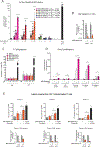Small Molecule Targeting of Specific BAF (mSWI/SNF) Complexes for HIV Latency Reversal
- PMID: 30197195
- PMCID: PMC6404985
- DOI: 10.1016/j.chembiol.2018.08.004
Small Molecule Targeting of Specific BAF (mSWI/SNF) Complexes for HIV Latency Reversal
Abstract
The persistence of a pool of latently HIV-1-infected cells despite combination anti-retroviral therapy treatment is the major roadblock for a cure. The BAF (mammalian SWI/SNF) chromatin remodeling complex is involved in establishing and maintaining viral latency, making it an attractive drug target for HIV-1 latency reversal. Here we report a high-throughput screen for inhibitors of BAF-mediated transcription in cells and the subsequent identification of a 12-membered macrolactam. This compound binds ARID1A-specific BAF complexes, prevents nucleosomal positioning, and relieves transcriptional repression of HIV-1. Through this mechanism, these compounds are able to reverse HIV-1 latency in an in vitro T cell line, an ex vivo primary cell model of HIV-1 latency, and in patient CD4+ T cells without toxicity or T cell activation. These macrolactams represent a class of latency reversal agents with unique mechanism of action, and can be combined with other latency reversal agents to improve reservoir targeting.
Keywords: ARID1A; BAF complex; HIV-1 latency; SWI/SNF; chromatin remodeling inhibitor; high-throughput screening.
Copyright © 2018 Elsevier Ltd. All rights reserved.
Conflict of interest statement
Figures





Comment in
-
A BAF'ling Approach to Curing HIV.Cell Chem Biol. 2018 Dec 20;25(12):1441-1442. doi: 10.1016/j.chembiol.2018.12.007. Cell Chem Biol. 2018. PMID: 30576660 Free PMC article.
Similar articles
-
Small Molecule Inhibitors of BAF; A Promising Family of Compounds in HIV-1 Latency Reversal.EBioMedicine. 2015 Nov 27;3:108-121. doi: 10.1016/j.ebiom.2015.11.047. eCollection 2016 Jan. EBioMedicine. 2015. PMID: 26870822 Free PMC article.
-
Repressive LTR nucleosome positioning by the BAF complex is required for HIV latency.PLoS Biol. 2011 Nov;9(11):e1001206. doi: 10.1371/journal.pbio.1001206. Epub 2011 Nov 29. PLoS Biol. 2011. PMID: 22140357 Free PMC article.
-
The Short Isoform of BRD4 Promotes HIV-1 Latency by Engaging Repressive SWI/SNF Chromatin-Remodeling Complexes.Mol Cell. 2017 Sep 21;67(6):1001-1012.e6. doi: 10.1016/j.molcel.2017.07.025. Epub 2017 Aug 24. Mol Cell. 2017. PMID: 28844864 Free PMC article.
-
The BAF complex and HIV latency.Transcription. 2012 Jul-Aug;3(4):171-6. doi: 10.4161/trns.20541. Epub 2012 Jul 1. Transcription. 2012. PMID: 22771990 Free PMC article. Review.
-
HIV-1 Transcription Inhibitors Increase the Synthesis of Viral Non-Coding RNA that Contribute to Latency.Curr Pharm Des. 2017;23(28):4133-4144. doi: 10.2174/1381612823666170622101319. Curr Pharm Des. 2017. PMID: 28641535 Review.
Cited by
-
Gliotoxin, identified from a screen of fungal metabolites, disrupts 7SK snRNP, releases P-TEFb, and reverses HIV-1 latency.Sci Adv. 2020 Aug 12;6(33):eaba6617. doi: 10.1126/sciadv.aba6617. eCollection 2020 Aug. Sci Adv. 2020. PMID: 32851167 Free PMC article.
-
Activity-assembled nBAF complex mediates rapid immediate early gene transcription by regulating RNA polymerase II productive elongation.Cell Rep. 2024 Nov 26;43(11):114877. doi: 10.1016/j.celrep.2024.114877. Epub 2024 Oct 15. Cell Rep. 2024. PMID: 39412992 Free PMC article.
-
Using Chemical Epigenetics to Target Cancer.Mol Cell. 2020 Jun 18;78(6):1086-1095. doi: 10.1016/j.molcel.2020.04.023. Epub 2020 May 13. Mol Cell. 2020. PMID: 32407673 Free PMC article. Review.
-
The Role of SWI/SNF Complex in Bladder Cancer.J Cell Mol Med. 2025 Jan;29(1):e70348. doi: 10.1111/jcmm.70348. J Cell Mol Med. 2025. PMID: 39779467 Free PMC article. Review.
-
A non-canonical BRD9-containing BAF chromatin remodeling complex regulates naive pluripotency in mouse embryonic stem cells.Nat Commun. 2018 Dec 3;9(1):5139. doi: 10.1038/s41467-018-07528-9. Nat Commun. 2018. PMID: 30510198 Free PMC article.
References
Publication types
MeSH terms
Substances
Grants and funding
LinkOut - more resources
Full Text Sources
Other Literature Sources
Molecular Biology Databases
Research Materials
Miscellaneous

